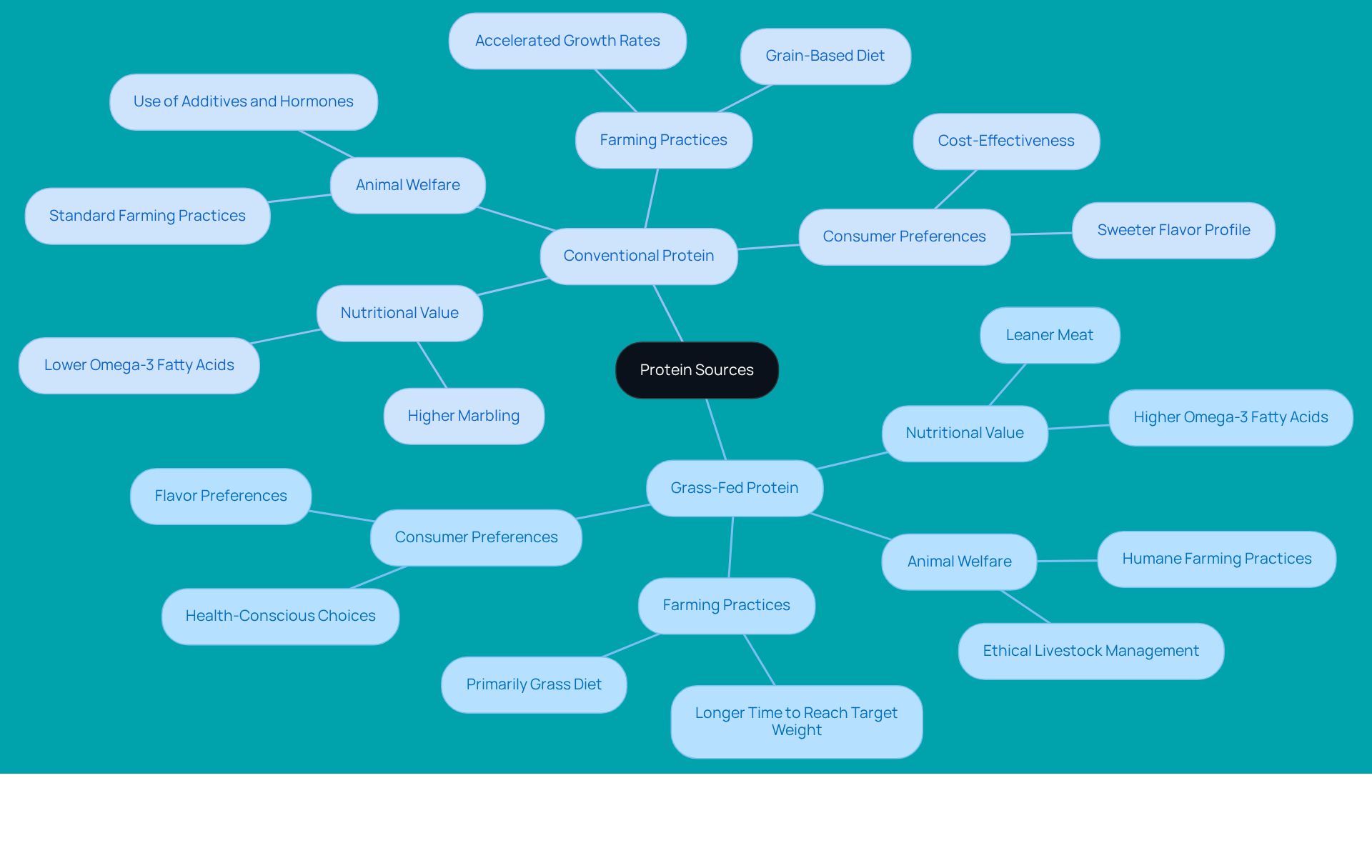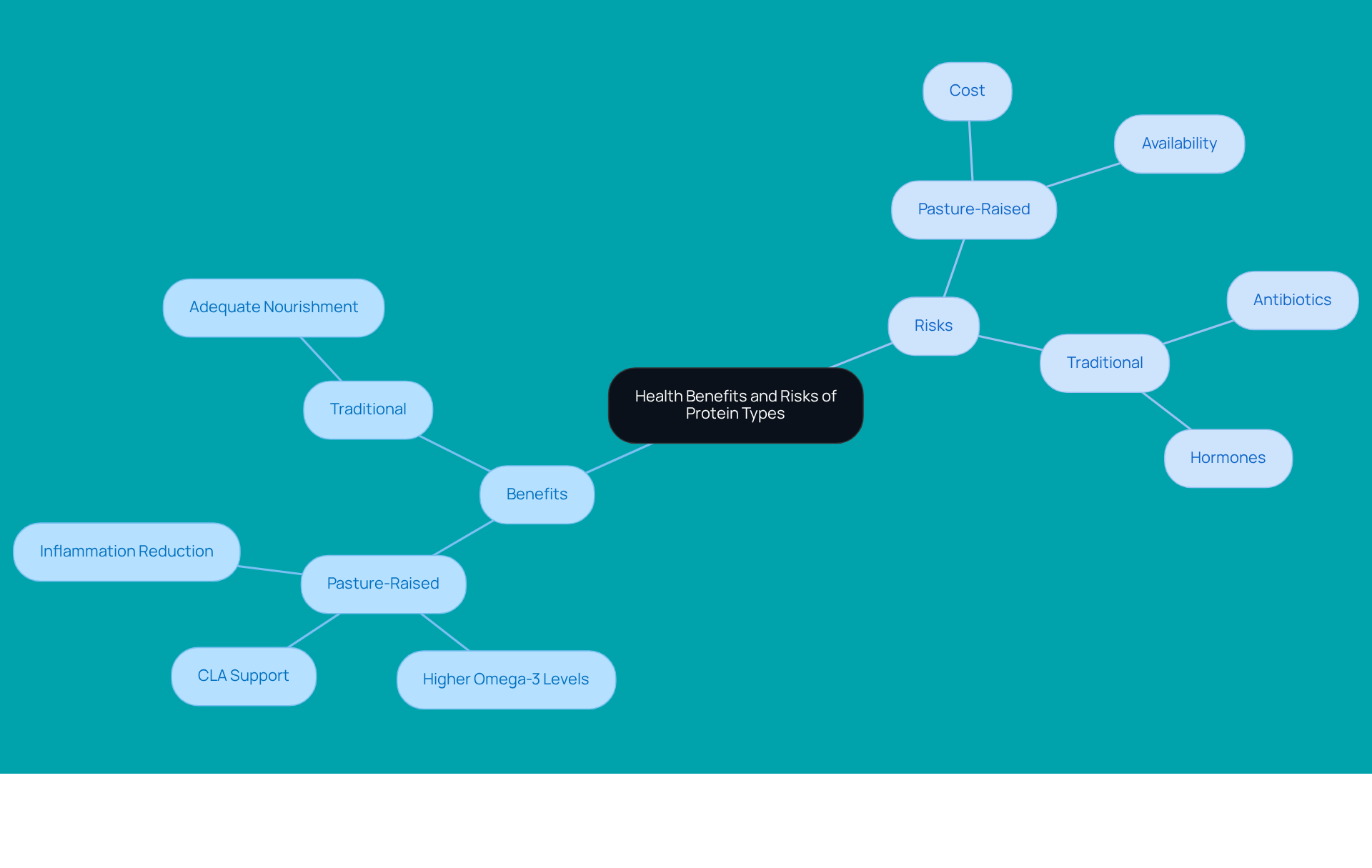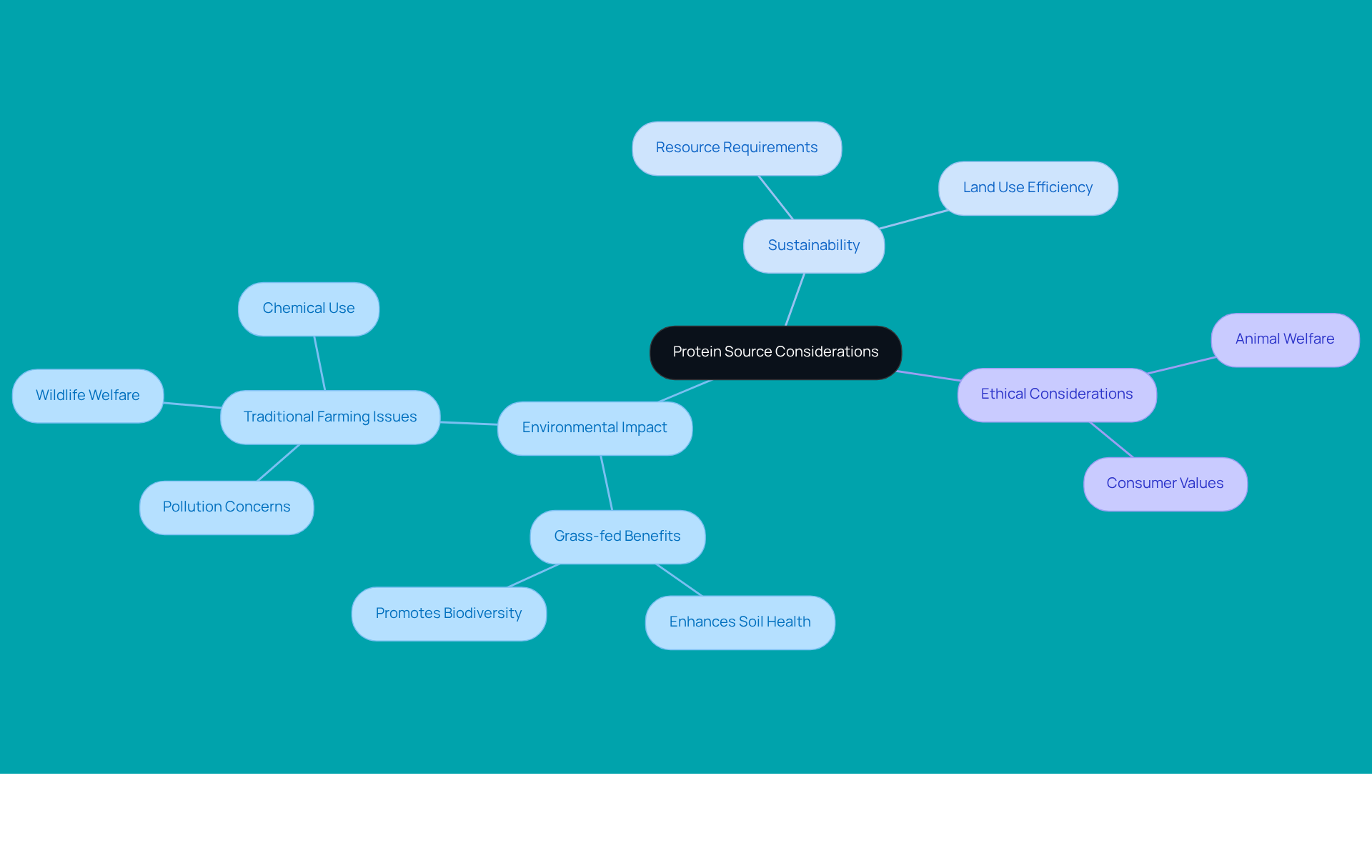Overview
Are you looking for a healthier protein option? Grass-fed protein might just be what you need. It's often seen as a better choice than conventional protein, thanks to its higher levels of omega-3 fatty acids and the improved animal welfare practices that come with its production.
Imagine if you could nourish your body while also supporting ethical farming practices. Studies show that pasture-raised cattle boast significantly more omega-3s and essential vitamins. This means that not only are you making a choice for your health, but you're also contributing to a more compassionate approach to farming.
You might be wondering about the environmental impacts of different farming methods. It's important to consider how our food choices affect the planet. Grass-fed options often come with a smaller ecological footprint, making them appealing to those who care about sustainability.
So, why not take a step towards better health and ethical eating? By choosing grass-fed protein, you're not just fueling your body; you're also supporting practices that align with your values. Together, we can make choices that benefit our health and the world around us. Let's embrace this journey towards wellness!
Introduction
The debate between grass-fed and conventional protein sources goes beyond mere taste; it taps into our deeper concerns about health, ethics, and sustainability. As more consumers seek options that resonate with their values, understanding the nutritional differences and ethical implications of these protein sources becomes essential.
Imagine if your choices could positively impact not just your health but also the well-being of our planet and its inhabitants. How do these decisions shape our world? This article explores key insights that can empower you to make informed choices on your journey toward a healthier lifestyle. Together, let’s navigate this important conversation.
Understanding Grass-Fed and Conventional Protein
Grass-fed protein comes from animals that are raised primarily on a diet of grass and forage, which aligns with their natural feeding behaviors. This farming method is often linked to more humane practices and better welfare for livestock. In contrast, traditional sources of nutrition typically involve livestock fed grain-based diets, which may include additives and hormones to accelerate growth. These differences are crucial, as they not only affect the nutritional value of the food but also raise significant ethical concerns about livestock management practices.
Imagine if you could choose a food source that not only nourishes your body but also supports ethical farming. Grass-fed protein is frequently promoted as more sustainable and beneficial, thanks to the natural diets of the livestock. For example, pasture-raised cattle contain about 30 milligrams more omega-3 fatty acids compared to their grain-finished counterparts, enhancing their nutritional profile. Moreover, the production of grass-fed protein often emphasizes ethical livestock management, prioritizing the welfare of the animals throughout their lives.
You might be wondering how this impacts your choices. Statistics show that pasture-raised beef is generally leaner, as it takes longer for cattle to reach target weights, resulting in less marbling. This farming approach not only promotes animal welfare but also appeals to consumers who are increasingly aware of the ethical implications of their food choices. While traditional sources of nutrients may be more accessible and usually cheaper, the growing awareness of animal welfare concerns is sparking interest in pasture-raised alternatives, particularly grass-fed protein, which many view as a more ethical option for health-conscious buyers.
However, it’s important to recognize that choosing pasture-raised meat doesn’t guarantee that cattle never consumed grain. Flavor preferences also play a significant role in consumer decisions between pasture-raised and grain-finished meat. Together, let’s explore these choices and consider how they align with our values and health goals.

Nutritional Comparison: Grass-Fed vs. Conventional Protein
Are you looking to enhance your nutrition and support your health? The answer you’ve been searching for might just be grass-fed protein. It’s celebrated for its impressive nutritional profile, especially when it comes to omega-3 fatty acids and conjugated linoleic acid (CLA). These nutrients are known to promote heart health and assist with weight management, making them essential for anyone focused on their well-being.
Imagine this: pasture-raised cattle can have up to five times more omega-3s than their grain-finished counterparts. That’s about 70-80 mg of omega-3 per 100g compared to just 20-30 mg in conventional meat. This significant difference means that choosing options with grass-fed protein can truly make a difference in your diet. Plus, these sources are often richer in vitamins A and E, along with antioxidants, which can further boost your health.
When you enjoy grass-fed meat, you’re getting approximately 64mg of long-chain omega-3 per 100g portion—much more than the 36mg found in conventional meat. And let’s not forget about the omega-6 to omega-3 ratio; pasture-raised beef typically ranges from 2:1 to 3:1, while grain-fed beef can exceed 10:1. This comparison highlights the importance of selecting food sources that align with your dietary goals, especially if you’re prioritizing omega-3 intake and overall nutritional quality.
As you plan your next meal, consider the benefits of incorporating grass-fed protein. It’s not just about what you eat; it’s about nourishing your body and supporting your health journey. Together, let’s make choices that empower us to live our best lives.

Health Benefits and Risks of Each Protein Type
Are you aware of the health benefits that pasture-raised sources can offer? These foods have the potential to reduce inflammation and boost cardiovascular health, thanks to their higher omega-3 levels. Imagine incorporating these nutrient-rich options into your diet! Additionally, the presence of CLA in pasture-raised products may support fat loss and muscle gain, which many of us strive for in our wellness journeys.
However, you might be wondering about the differences between sources of grass fed protein and traditional options. Some research suggests that the health benefits may not be as pronounced as once thought, particularly when it comes to muscle recovery after exercise. It’s important to consider that while traditional sources may not be as nutrient-dense, grass fed protein can still provide adequate nourishment for muscle maintenance and growth.
As you navigate your food choices, it’s essential to weigh these benefits against potential risks, such as the presence of antibiotics and hormones in some conventional products. Together, let’s make informed decisions that align with our health goals. Your wellness journey is important, and every choice counts!

Environmental and Ethical Considerations
When it comes to choosing protein sources, many of us are increasingly concerned about the impact on our planet. Grass fed protein often stands out as a more environmentally friendly option. Why? It typically involves pasture-based farming practices that can enhance soil health and promote biodiversity. But let’s pause for a moment. While this sounds promising, the reality is that the land and resources required for pasture-based farming can be quite substantial. This raises important questions about its overall sustainability.
On the flip side, traditional farming methods, while often more efficient in terms of land use, can lead to worries about pollution, wildlife welfare, and the use of chemicals. It’s a complex issue, and it’s completely understandable to feel overwhelmed. We all want to make choices that are not only good for our health but also kind to the environment.
Ethical considerations also come into play here. Grass-fed farming is generally associated with better animal welfare standards, which many consumers deeply care about, especially when it comes to grass fed protein. As you navigate your protein choices, it’s essential to weigh these factors carefully. How do you balance your personal health goals with the environmental and ethical implications of your choices?
Imagine if you could find a protein source that aligns with your values and supports your wellness journey. By considering the impact of your food choices, you can take meaningful steps toward a healthier lifestyle. Together, let’s explore these options and make informed decisions that reflect our commitment to both our health and the planet.

Conclusion
Grass-fed protein stands out as a thoughtful alternative to conventional sources, addressing both health and ethical concerns. By focusing on natural diets for livestock, these options not only boost nutritional value but also promote humane farming practices. This shift towards responsible food choices resonates with health-conscious consumers who want to nourish their bodies while making ethical decisions.
Imagine if you could enjoy your meals knowing they support your health and the well-being of animals. Throughout this article, we’ve explored the remarkable nutritional benefits of grass-fed protein, such as higher levels of omega-3 fatty acids and essential vitamins. The environmental and ethical implications of how we source our protein further emphasize the importance of making informed choices. While traditional protein sources might be easier to find, the growing awareness of their health risks and ethical concerns invites us to rethink our dietary preferences.
Ultimately, the choice between grass-fed and conventional protein goes beyond nutrition; it reflects our personal values and commitment to sustainability. By embracing grass-fed options, we can contribute to a healthier lifestyle, promote animal welfare, and support environmentally friendly practices. Choosing wisely empowers us to take meaningful steps toward a future where health and ethical considerations truly go hand in hand. Together, let’s make choices that reflect our values and foster a better world.
Frequently Asked Questions
What is grass-fed protein?
Grass-fed protein comes from animals that are primarily raised on a diet of grass and forage, aligning with their natural feeding behaviors.
How does grass-fed protein differ from conventional protein?
Conventional protein typically comes from livestock fed grain-based diets, which may include additives and hormones to accelerate growth, while grass-fed protein emphasizes more humane practices and better welfare for livestock.
What are the nutritional benefits of grass-fed protein?
Grass-fed protein is often linked to a better nutritional profile, containing higher levels of omega-3 fatty acids compared to grain-finished counterparts.
What ethical considerations are associated with grass-fed protein?
Grass-fed protein production emphasizes ethical livestock management and prioritizes the welfare of animals throughout their lives, which appeals to consumers concerned about animal welfare.
How does the leanness of pasture-raised beef compare to conventional beef?
Pasture-raised beef is generally leaner because it takes longer for cattle to reach target weights, resulting in less marbling compared to grain-finished beef.
Why might consumers choose grass-fed protein over conventional options?
Consumers may choose grass-fed protein due to growing awareness of animal welfare concerns and the perception of it being a more ethical option for health-conscious buyers.
Does choosing pasture-raised meat guarantee that cattle never consumed grain?
No, choosing pasture-raised meat does not guarantee that cattle never consumed grain, as flavor preferences also influence consumer decisions between pasture-raised and grain-finished meat.




